Faber BELA30SS600B, BELA36SS600B INSTALLATION INSTRUCTIONS AND OPERATION MANUAL
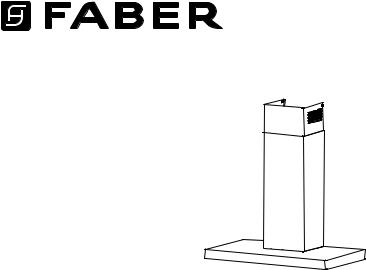
BELLA 30" / 36"
Installation Instructions Use and Care Information
Instructions d'installation Utilisez et d'entretien
BELA30SS600-B BELA36SS600-B
READ AND SAVE THESE INSTRUCTIONS BEFORE YOU START
INSTALLING THIS RANGEHOOD
WARNING: - TO REDUCE THE RISK OF A RANGE TOP GREASE FIRE:
a)Never leave surface units unattended at high settings. Boilovers cause smoking and greasy spillovers that may ignite. Heat oils slowly on low or medium setting.
b)Always turn hood ON when cooking at high heat or when flambeing food (i.e. Crepes
Suzette, Cherries Jubilee, Peppercorn Beef Flambé).
c)Clean ventilating fans frequently. Grease should not be allowed to accumulate on fan or filter.
d)Useproperpansize. Alwaysusecookwareappropriateforthesizeofthesurfaceelement.
WARNING: - TO REDUCE THE RISK OF INJURY TO PERSONS IN THE EVENT OF A RANGE TOP GREASE FIRE, OBSERVE THE FOLLOWING*:
a)SMOTHERFLAMESwithaclose-fittinglid,cookiesheet,ormetaltray,thenturnofftheburner. BE CAREFUL TO PREVENT BURNS. If the flames do not go out immediately EVACUATE
AND CALL THE FIRE DEPARTMENT.
b)NEVER PICK UP A FLAMING PAN - You may be burned.
c)DO NOT USE WATER, including wet dishcloths or towels - a violent steam explosion will result.
d)Use an extinguisher ONLY if:
1.You know you have a Class ABC extinguisher, and you already know how to operate it.
2.Thefireissmallandcontainedintheareawhereitstarted.
3.Thefiredepartmentisbeingcalled.
4.Youcanfightthefirewithyourbacktoanexit.
* Based on "Kitchen Firesafety Tips" published by NFPA
WARNING - TO REDUCE THE RISK OF FIRE OR ELECTRIC SHOCK, do not use this fan with any solid-state speed control device.
WARNING - TO REDUCE THE RISK OF FIRE, ELECTRICAL SHOCK, OR INJURY TO PERSONS, OBSERVE THE FOLLOWING:
1.Use this unit only in the manner intended by the manufacturer. If you have any questions, contact the manufacturer.
2.Before servicing or cleaning unit, switch power off at service panel and lock the service disconnecting means to prevent power from being switched on accidentally. When the service disconnecting means cannot be locked, securely fasten a prominent warning device, such as a tag, to the service panel.
CAUTION: For General Ventilating Use Only. Do Not Use To Exhaust Hazardous or Explosive Materials and Vapors.
WARNING - TO REDUCE THE RISK OF FIRE, ELECTRICAL SHOCK, OR INJURY TO PERSONS, OBSERVE THE FOLLOWING:
1.InstallationWorkAndElectricalWiringMustBeDoneByQualifiedPerson(s)InAccordance With All Applicable Codes And Standards, Including Fire-Rated Construction.
2.Sufficient air is needed for proper combustion and exhausting of gases through the flue (chimney) of fuel burning equipment to prevent backdrafting. Follow the heating equipment manufacturer's guideline and safety standards such as those published by the National Fire Protection Association (NFPA), and the American Society for Heating, Refrigeration and Air Conditioning Engineers (ASHRAE), and the local code authorities.
2

3.When cutting or drilling into wall or ceiling, do not damage electrical wiring and other hidden utilities.
4.Ducted fans must always be vented to the outdoors.
ALL WALL AND FLOOR OPENINGS WHERE THE RANGEHOOD IS INSTALLED MUST
BE SEALED.
This rangehood requires at least 24" of clearance between the bottom of the rangehood and the cooking surface or countertop. This hood has been approved by UL at this distance from the cooktop. Overhead cabinets on both sides of this unit must be a minimum of 18" above the cooking surface or countertop. Consult the cooktop or range installation instructions given by the manufacturer before making any cutouts. MOBILE HOME INSTALLATION The installation of this rangehood must conform to the Manufactured Home Construction and Safety Standards, Title 24 CFR, Part 3280 (formerly Federal Standard for Mobile Home Construction and Safety, Title 24, HUD, Part 280). See Electrical Requirements.
VENTING REQUIREMENTS
Determine which venting method is best for your application. Ductwork can extend either through the wall or the roof.
Thelengthoftheductworkandthenumberofelbowsshouldbekepttoaminimumtoprovideefficient performance. The size of the ductwork should be uniform. Do not install two elbows together. Use duct tape to seal all joints in the ductwork system. Use caulking to seal exterior wall or floor opening around the cap.
Flexible ductwork is not recommended. Flexible ductwork creates back pressure and air turbulence that greatly reduces performance.
Make sure there is proper clearance within the wall or floor for exhaust duct before making cutouts.
Do not cut a joist or stud unless absolutely necessary. If a joist or stud must be cut, then a supporting frame must be constructed.
WARNING - To Reduce The Risk Of Fire, Use Only Metal Ductwork.
CAUTION-Toreduceriskoffireandtoproperlyexhaustair,besuretoductairoutside–Do notventexhaustairintospaceswithinwallsorceilingsorintoattics,crawlspaces,orgarages.
Cold Weather installations
An additional back draft damper should be installed to minimize backward cold air flow and a nonmetallic thermal break should be installed to minimize conduction of outside temperatures as part of the vent system. The damper should be on the cold air side of the thermal break. The break should be as close as possible to where the vent system enters the heated portion of the house.
! WARNING
•Venting system MUST terminate outside the home.
•DO NOT terminate the ductwork in an attic or other enclosed space.
•DO NOT use 4" laundry-type wall caps.
•Flexible-type ductwork is not recommended.
•DO NOT obstruct the flow of combustion and ventilation air.
•Failure to follow venting requirements may result in a fire.
3
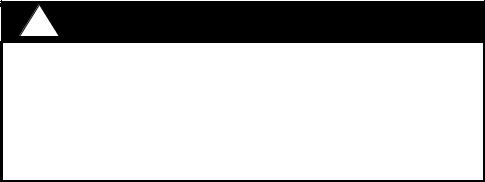
! WARNING
•Electrical ground is required on this rangehood.
•If cold water pipe is interrupted by plastic, nonmetallic gaskets or other materials, DO NOT use for grounding.
•DO NOT ground to a gas pipe.
•DO NOT have a fuse in the neutral or grounding circuit. A fuse in the neutral or grounding circuit could result in electrical shock.
•Check with a qualified electrician if you are in doubt as to whether the rangehood is properly grounded.
•Failure to follow electrical requirements may result in a fire.
4
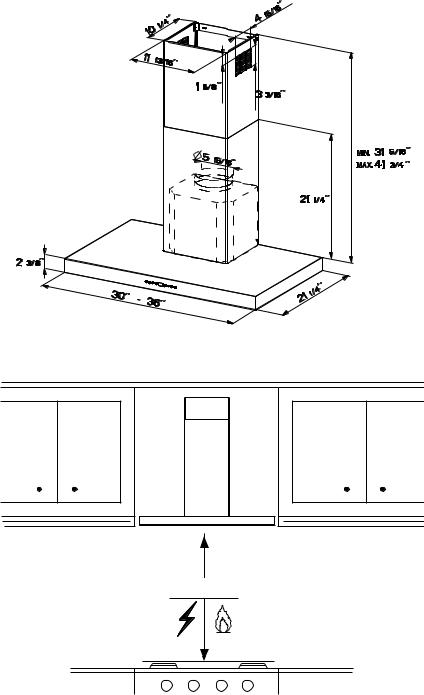
RANGEHOOD DIMENSIONS
Min. 24"
5
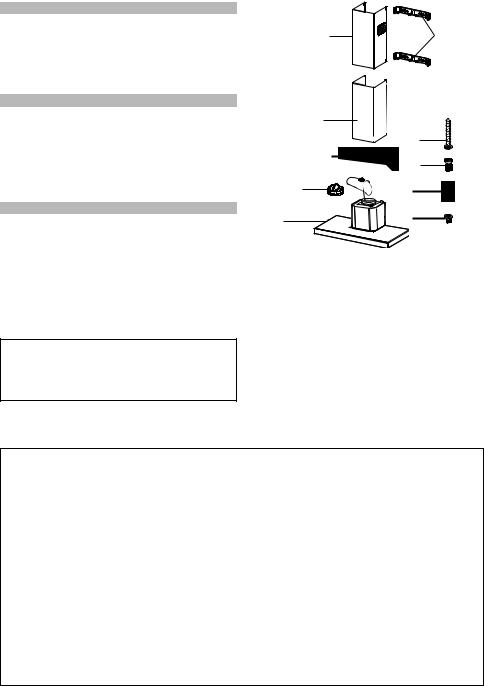
MAIN PARTS
Components
Ref. |
Qty. |
Product Components |
|
|
1 |
1 |
Hood Body, complete with: Con- |
2.1 |
|
2 |
1 |
trols, Light, Filters, Blower. |
7.2.1 |
|
Telescopic Chimney comprising: |
|
|
||
2.1 |
1 |
Upper Section |
|
|
2.2 |
1 |
Lower Section |
|
|
10 |
1 |
Damper ø 5 7/8" |
|
|
Ref. |
Qty. |
Installation Components |
|
|
7.2.1 |
2 |
Upper Chimney Section Fixing |
2.2 |
|
|
|
Brackets |
|
12a |
7.3 |
1 |
Cooker Hood Fixing Brackets |
|
|
|
|
|||
12a |
6 |
Screws 3/16" x 1 3/4" |
7.3 |
12b |
12b |
4 |
Screws 1/8" x 3/8" |
|
12c |
12c |
2 |
Screws |
10 |
|
12d |
2 |
Screws 1/8" x 3/8" |
|
12d |
|
Qty. |
Documentation |
1 |
|
|
1 |
Instruction Manual |
|
|
Parts needed
- 6" Round Metal ductwork
Available Accessories
-Direct Connect Wiring Box sku # number: - WIREBOX
-High Ceiling Chimney Kit - Upper and Lower Chimney Flue to replace the original flue's to fit up to 11' ceilings - sku# HIGH3
-Ductless Kit - Includes Ductless Diverter, Charcoal Filters - sku# DUCT4
-6" Make-Up Air Damper Kit - MUDAMPER6
-8" Make-Up Air Damper Kit - MUDAMPER8
-CFM Reducer Kit - CFMRED
-Activated Charcoal Filter Accessory - sku# FILTER2
-Wireless Remote Control Accessory - REMCTRL
6
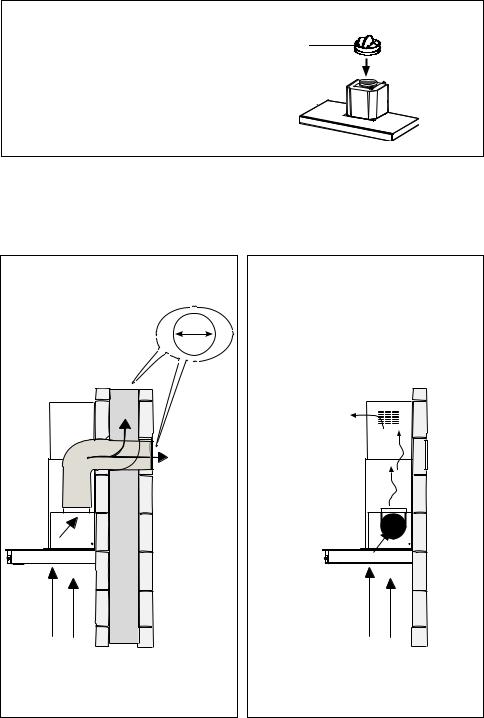
Only for Ducted Venting Installation
Install Damper that is included with the Hood before connecting to the ductwork.
Choose your ducting method |
||
Ducted Venting Options Installation |
Non Ducted - Recirculation Option |
|
6 " |
|
|
Vertical |
|
|
Horizontal |
Requires |
|
purchase of |
||
|
||
|
Activated |
|
|
Charcoal |
|
|
Accessory |
|
7 |
|
|

1
Draw a vertical line on the supporting wall as high as practical, at the center of the area in which the hood will be installed.
Draw a horizontal line at where the bottom edge of the hood will be located as indicated in the figure that is a minimum of 24" above cooking surface.
2
|
|
>´ |
|
|
5 |
6 |
|
|
|
2.1 |
|
<![if ! IE]> <![endif]>2.1 |
7.2.1 |
|
3 |
4 |
|
|
|
|
6 |
|
||
|
|
|
|
|
4 9/16” 4 |
9/16” |
5 |
6 |
|
3 |
4 |
|
||
|
|
1 2 |
|
|
1 |
2 |
<![if ! IE]> <![endif]>5/8” |
|
|
|
|
|
|
|
|
|
<![if ! IE]> <![endif]>12 |
|
|
|
|
|
5 |
6 |
|
|
|
3 |
4 |
|
|
|
1 2 |
|
| <![if ! IE]> <![endif]>24” |
|
<![if ! IE]> <![endif]>24” |
´ |
|
|
6 |
|
||
|
|
|
||
Draw a horizontal line where indicated above the cooking surface.
Place a bracket 7.2.1 on the wall as shown about 1 1/8" from the ceiling or upper limit, aligning the center (notch) with the vertical reference line and mark the wall at the centers of the holes in the bracket.
Place the second bracket 7.2.1 on the wall as shown, below the first bracket, at the height of the upper chimney section supplied and aligning the center (notch) with the vertical line.
Mark the wall at the centers of the holes in the bracket and mark the point 1 and 2 for the Hood Body installation as shown(12 5/8" from the horizontal line and 4 9/16" from the vertical line).
Drill ø 5/16" holes at all the center points marked (point 1,2,3,4,5,6) as shown.
8
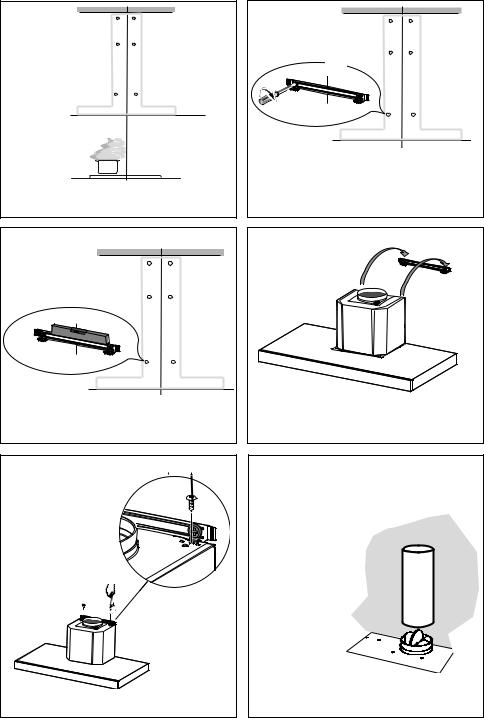
3
11I = 6x
Installation screws provided must be secured with wall plugs (purchase separately).
4 |
|
|
2X |
12a |
I = |
|
Insert the two screws 12a supplied with the hood into the Fixing Bracket as shown and do not tighten all the way to wall leaving 3/16" of the screw heads exposed.
5
I =
Use a level to insure that Fixing Bracket is level and then fully secure the two screws.
7 |
12c |
|
Tighten the 2 screws 12c as shown.
6
Hook the hood body onto the hood body fixing bracket 7.3.
8 Vertical or Horizontal Ducting Installation
Install Roof or Wall Cap purchased separately. Connect the 6" metal ductwork to the Roof or Wall Cap and then attach ductwork.
9
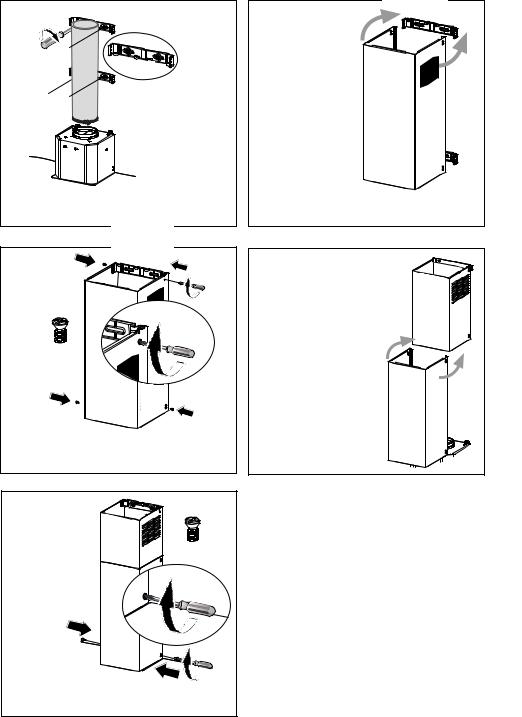
9 |
L = 4x |
12a |
Installthe2fixingbrackets7.2.1tothemiddleand |
upperholesandsecurewithscrews12aasshown. |
11 |
N = 4x |
12b |
Secure the sides to the brackets by using the 4 screws 12b.
10 |
|
Slightly widen |
|
the two sides |
2.1 |
of the upper |
|
chimney and |
|
hook them |
|
behind the |
|
brackets 7.2.1, |
|
making sure |
|
that they are |
|
well seated. |
|
12 |
|
|
2.1 |
Slightly widen the two sides of the the lower chimney hood and hook
them between 2.2 the upper section and the
wall, making sure that they are properly housed.
13 |
N = 2x |
12d |
Fix the the |
lower chim- |
ney hood |
laterally to |
the hood |
body using |
the 2 screws |
12d supplied. |
10
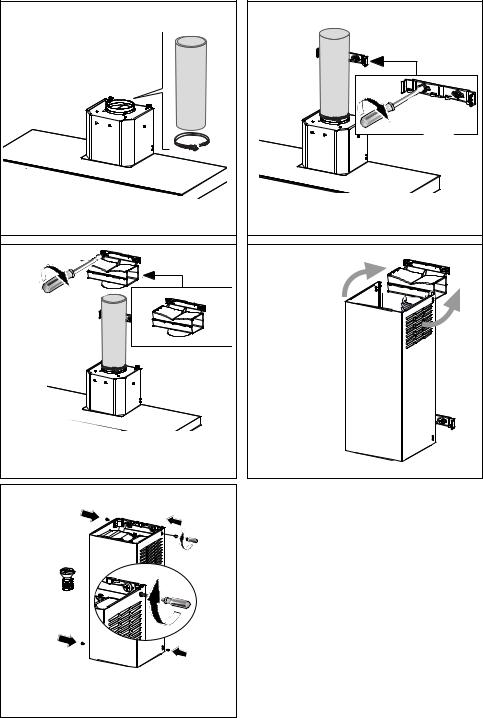
14 Non-Ducted Recirculation Option
Only for the recirculation version, connect the hood to the Air outlet.
16 |
Fix the Ductless Diverter with two screws 12a supplied as shown.
18
15
12a |
Fix the lower Bracket 7.2.1 with two screws 12a supplied as shown.
17
Slightly widen
the two sides of 2.1 the upper chim-
ney and hook them behind the brackets and connect to the Ductless Diverter, making sure that they are well seated.
12bN = 4x
Secure the sides to the brackets by using the 4 screws 12b.
11
